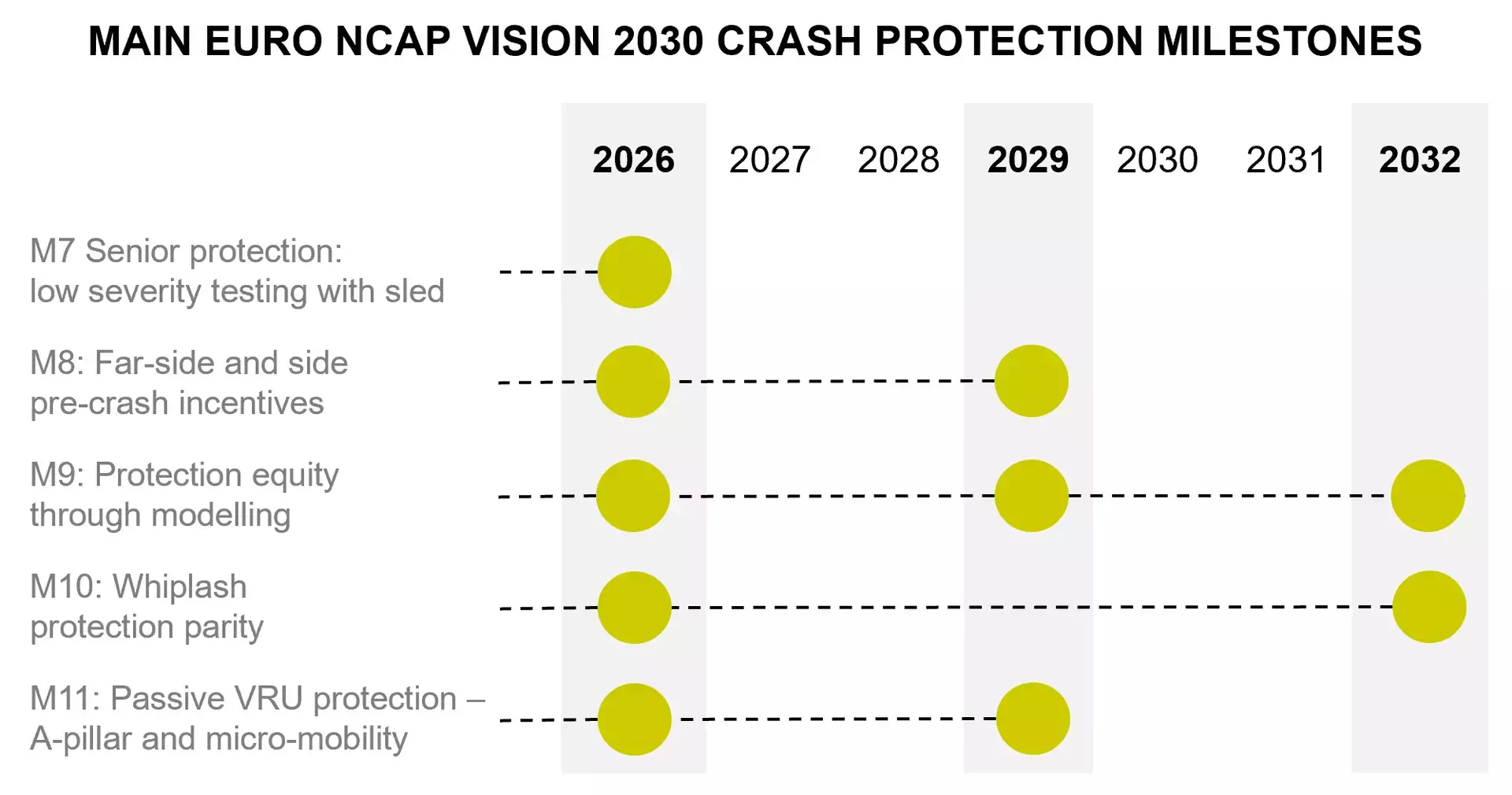
Euro NCAP Provides Vision 2030 to Deliver a Clearer Path for Consumer Vehicle Safety Ratings
The European New Car Assessment Program (Euro NCAP), which was established in 1997, composed of seven European Governments and consumer organizations in every European country, has just published its Vision 2030 report giving guidance on strategic goals and the future course and opportunities for consumer safety. This year Euro NCAP celebrates its 25th anniversary in providing information and advice to consumers that allow them to make the most relevant choices for the safety of their families and all road users across Europe.
Today, Euro NCAP is faced with the challenge of assessing many new technologies across the safety landscape and understanding their importance to the zero fatalities and severe injury goals that lie ahead. Automotive makers are spending billions of euros on the concept of self-driving vehicles with the perception that human error can be avoided and get us closer to the zero-vision future.
Included in the Vision 2030 are new initiatives centered around four distinct categories: Safe Driving, Crash Avoidance, Crash Protection, and Post-Crash Safety. There are significant upgrades to passive safety including the increased use of the THOR-50M advanced ATD and the planned inclusion of the THOR-5F female dummy.
The drive from the automotive industry and society to transform mobility into an electric and automated future inspires these new challenges and compels frequent updates to the game plan. Advanced technology is seen as key to enhance adaptive safety and occupant classification for smarter restraint and airbag deployment. A few highlights of this vision to help the industry bring increasingly safer cars to the market are detailed in the following objectives.
But with the ever-complicated evaluations performed nowadays, one aim of Euro NCAP is to simplify testing with a focus on four distinct categories: Safe Driving, Crash Avoidance, Crash Protection, and Post-Crash Safety.
The five-star overall safety ratings used by Euro NCAP and the other global NCAP programs including the US is an extremely important asset, as Euro NCAP points out, and provides a strong indicator for passenger car safety. A few updates are being announced including brain injury risk assessment in frontal offset mobile barrier tests, virtual testing for far-side protection, a step-function for vulnerable road user protection, revised subsystem tests for cyclist head injuries, and, for the first time, new crash avoidance scenario testing including power-two-wheelers (PTW). In-cabin monitoring assessments will be added to measure technology that detects children accidentally left behind in vehicles and driver monitoring systems for fatigue, distraction, and sudden health emergencies.
Passive safety will get a greater focus on gender equality and the aging population of car drivers and occupants, especially for MAIS3+ and impairing, long term injuries. With more emphasis on gender equity and a car “designed for all,” the agency proposes to adopt the latest generation THOR-5F small female and THOR-50M mid-size male crash dummies. Although some technical challenges still remain with advanced ATD adoption, both THOR dummies will be used as driver and front passenger, respectively, in a revised low severity full-width barrier test, and applying criteria and injury limits that promote restraints that better protect elderly occupants. The mid-sized male Hybrid-III 50M front passenger will eventually be replaced by THOR-5F in the Mobile Progressive Deformable barrier (MPDB) test as well.
Passive safety will get a greater focus on gender equality and the aging population of car drivers and occupants, especially for MAIS3+ and impairing, long term injuries.
Full-scale testing will be complemented by sled testing and virtual simulations to evaluate lower extremity injury risk, submarining, and the robustness of (adaptive) restraint systems, covering more variations in driver characteristics (age, gender, weight, and stature), seating postures (such as reclined seats) and crash severity. These tests will still require validation, but will help advance safety development and keep safety programs feasible and manageable. But it’s worth noting that virtual crash test dummy models will eventually be replaced by digital human body models that offer enhanced biofidelity and higher levels of injury prediction and diversity.
For the foreseeable future, the protection of the 6- and 10-year-old child will continue to be used in the frontal offset and side barrier crash tests, with improved biomechanical criteria and limits.
With this year’s update to UN regulation No. 17 for whiplash, it is expected that new vehicles will have new requirements to meet by 2025. It is noted though that Euro NCAP’s geometric modifier and back set criteria have been called into question for the protection of female occupants and brings to light the need to address relative injury risk in both the short and long term. It is also significant to recognize that more recent whiplash data is required and that biological and anthropomorphic differences in gender more clearly identified.
In active safety, tests will become less idealized, will simulate real traffic environments more closely, and will take best practice in human machine interface design into account. Lane Support systems (LSS), Autonomous Emergency Braking (AEB) and Autonomous Emergency Steering (AES) systems are ever increasingly being adopted in newer automobiles, necessitating rigorous and more focused crash avoidance assessments. Such initiatives include adding additional turning cyclist scenarios, adding PTW and powered standing scooters (PSS), and more obstructed VRU test situations to better evaluate a vehicle’s performance to increased complexity.

Euro NCAP’s goal is to work closely with the industry to provide a better development path for advanced safety not only for all sizes and gender of vehicle occupants but also for all types of vulnerable road users. Although the global pandemic slowed down the initial publication of Vision 2030, Euro NCAP has nevertheless been able to formulate new ideas and better understand the future challenges ahead.
Read the full report Euro NCAP Vision 2030: a Safer Future for Mobility

Mark Brown
Mark is the Product Marketing Manager at Humanetics Safety and works closely with Engineering and Sales to develop and refine content that is both useful and informative for our industry. With over two decades of experience in crash test dummy product Quality, Technical, Sales, and Marketing, Mark produces a wide range of media and publications including our service bulletins, webinars, editorial articles, and contributes to our marketing collateral.